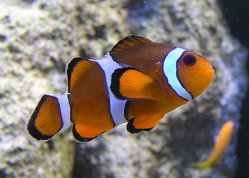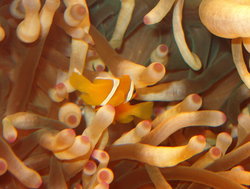Clown Fish
The Clownfish, or Anemonefish, are the subfamily Amphiprioninae of the family Pomacentridae. There are currently 27 species, of which one is in the genus Premnas and the rest are in the subfamily's type genus Amphiprion. more...
The other pomacentrids are called damselfish.
Clownfish are native to wide ranges of the warm waters of the Pacific; some species ranges overlap others. Clownfish are not found in the Atlantic. Clownfish live in a mutual relationship with sea anemones, or in some case settle in some varieties of soft corals, or large polyp stony corals. Once an anemone or coral has been adopted, the clownfish will defend it vigorously. However, clownfish in an aquarium environment can exist very well without an anemone, or with a . (This may be advisable as most anemones are extremely difficult to keep alive even for experienced aquarists.) The anemone is required in nature because reef life is dangerous for small, brightly colored fish with very poor swimming abilities; in an aquarium lacking predators it is not needed. For this reason, Clownfish never stray far from their host. In an aquarium, where they don't have to forage for food, it is very common for Clownfish to remain within 6-12 inches of their host for an entire lifetime.
Clownfish and Damselfish are the only species of fish which can avoid the stings of an anemone, which can be quite potent. The exact mechanism by which this is accomplished is the subject of debate, and there are several theories which may all be partly responsible. The details of these theories are complex, but they fall into two major categories. One theory is that their slime coating is based on sugar rather than proteins so anemones fail to recognize the fish as food and do not fire their nematocysts, or sting organelles. A similar theory is that the mucous coating mimicks the anemone's own coating, a theory that is bolstered by the fact that it takes several days for a Clownfish to adapt to a new species of anemone. There is no acclimation period when a Clownfish is moved to another anemone of the same species. It is interesting to note that not all anemones make suitable hosts--many can and will sting and eat Clownfish. Also, particular species of clownfish will only use particular species of host anemones in nature. In captivity, certain Clownfish species will adapt to certain other anemone species, but not many. Another likely possibility is that their unique movements, which are unlike any other fish, let the anemone know that they are not food. This theory is bolstered by the fact that juvenile Clownfish, which have no coating, will immediately seek refuge in any compatible anemone and will not be stung. Juvenile clownfish will not survive for long without the protection of an anemone, and few actually find one before being eaten.
Clownfish are among the few marine fish that can be bred in captivity in commercially-viable quantities at the time of this writing. Hobbyists are advised to purchase captive-born clownfish (and other marine animals) whenever possible. The Amphiprions are attractive in colour and usually wear bright colours. Example: orange, black, and white. They are good for a marine aquarium because they are friendly and easy to feed. They adapt well in captivity and can be easily studied for scientific research.
Clownfish lay eggs on any flat surface close to or under protection of their host anemones. These eggs are cared for by the male and hatched under complete darkness after a period of 7 to 10 days. Hatching occurs in a natural rhythm directly connected to the phases of the moon. Clownfish are omnivorous, their diets range from flakes to meat. They feed mostly on copepods and mysids, the undigested excrement from their host anemones.
Clownfish are relatively small organisms, fish in aquaria can grow to 9 cm (3.5 inches) in length, fish in the wild can grow to a length of 12 cm (5 inches). The maximum size varies by species, with males being significantly smaller than females.
Reproduction
Clownfish are protandrous hermaphrodites, meaning they are hatched as sexually immature fry. Based on signals from their environment and being physically mature (12-24 months) they will either remain sexually immature, change into a male or change into a male then female. A group of clownfish is always built into a hierarchy of this type, with the female (the largest and most aggressive) at the top. The change from juvenile to male, and male to female is irreversible. If the female should die or be removed from the group, the most dominant male then changes into a female, and the rest of the males move up a rank on the hierarchy.
In typical home aquaria, a juvenile only several months old can make the change from juvenile to male to female in as little as a month. Because of this, pairing clownfish can be a tricky proposition, as most hobbyists tend to select the largest and most dominant specimen (presumably a female) to mate with their own female. Usually two females will tend to fight regularly, and frequently lock jaws (some hobbyists describe it as kissing). In a successful pair, the male will exhibit submissive behavior. Usually, this behavior entails the more aggressive female darting at the male, and the male turning sideways and quivering.
Most common species of clownfish (A. ocellaris, A. percula etc.) are fairly easy to breed in the home aquarium. The female will be the larger of the pair, and the two fish will usually stay close to each other in one area of the tank or in a host anemone. After several months in a successful pair, the fish will begin spawning. The female's abdomen will bulge with eggs, ready to be deposited. She will usually find a flat surface near her host anemone (if present) to lay her eggs before they can be fertilized by the male. The eggs will normally hatch in 6-11 days depending on temperature and other water parameters. In home aquaria, the fry must be reared in a separate aquarium on a diet of rotifers then baby brine shrimp to have any chance of survival.
References in media
Clownfish featured prominently in the 2003 Pixar-animated movie Finding Nemo. Despite the content of the movie - wherein a young clownfish's father must rescue his son after being taken as a aquarists pet - public demand for clownfish as pets has tripled shortly after its release. Some environmental protection activists regard this as a catastrophe as clownfish are already facing the threat of extinction due to a reduction of their natural habitat (coral reefs) which in turn is due to global climate changes as well as pollution of the seas.
Read more at Wikipedia.org




